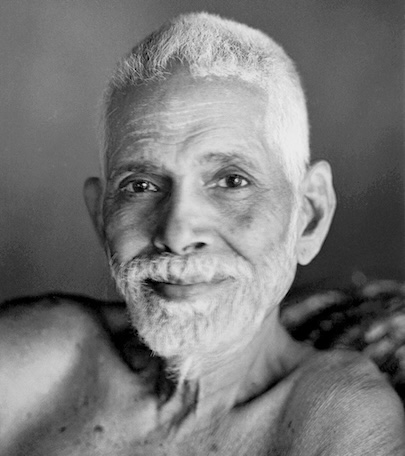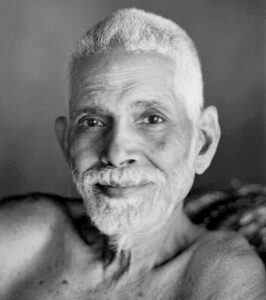Bhagavan Ramana Maharshi, perhaps modern India’s greatest sage, recommended Atma-Vichara or Self-inquiry as the best and most direct approach for Self-realization. However, a careful examination of his teachings reveals that he recommended yogic approaches of devotion, mantra or raja yoga – he encouraged whatever might aid a person in their sadhana.
The Maharshi emphasized a pure vegetarian diet as a crucial aid for clarity of mind. He noted the importance of satsangha or communion with spiritual teachers and aspirants. Pilgrimage to holy sites like the Arunachala mountain was very significant to him as well. He did spent several years of his early life at the Tiruvannamalai Shiva temple. Daily Vedic chanting goes on in his ashram to create an environment suitable for meditation, as well as regular Sri Chakra puja.
Though Bhagavan’s teaching is simple and direct, it is broad and flexible. It accepts all helpful yogic practices, even those that it may not specifically mention. The Maharshi’s path follows the integral approach of Vedic teachings going back thousands of years and, particularly, the Advaitic and yogic approaches taught by Shankaracharya (seventh century) that included devotional practices and raja yoga (as taught in texts like Saundarya Lahiri).
Many people today, particularly in the West, do not understand the interconnectedness of these various yogic disciplines and fail to understand their benefits. Simple formless Self-inquiry is difficult to sustain, except for very advanced aspirants who have well developed powers of attention and extreme dispassion from all external objects starting with the body itself.
Such detachment is, of course, extremely rare in this materialistic and sensate age. Additional practices are usually necessary to build the competence for this effort, which is said to be as daunting as scaling a steep rock face of a high mountain.
Actually all yogic practices done rightly are forms of vichara or inquiry into our true nature. Whether it is asana, pranayama, mantra or meditation, all prescribed to gain knowledge of the Atman or Purusha, which is the goal of Yoga as stated in theYoga Sutras (I.3) as “abidance in the Self-nature of the Seer.” Whatever yogic practices one does should be performed out of an attitude of inner inquiry or observation. In this way they all contribute to Self-inquiry and broaden its practice to encompass all aspects of our life.
At the same time we should never forget the centrality and ultimate goal of Self-realization.
Common Root of Thought, Breath and Speech
According to the Maharshi all thoughts are rooted in the I-thought that arises from the heart. Tracing the I-thought back to the heart one can merge into the pure I or pure consciousness beyond all thought. But the heart is the origin of prana and speech as well. In fact it is the origin of everything. Mind, prana and speech have a common root in the heart that is the fountain of awareness, energy and creativity.
Just as our thoughts arise from the I-thought in the heart so our breath arises from the great Prana in the heart. So too, our speech arises from the Divine Word or unstruck sound (anahata shabda) in the heart, the I-am-that-I am or OM.
Self-inquiry can work by tracing the origins of prana and speech into the heart, just as it can be done by following our thoughts.
Inquiry into the Word or Speech: Mantra-Vichara
This practice involves tracing the origin of sound and speech in the heart. For it one can use any mantra, particularly OM and other bija mantras (seed syllables) like HRIM, SHRIM or RAM, which exist at the level of primal sound. One follows the current of sound back to its origin to the inner silence at the core of our being.
Prana Vichara – Pranayama as Self-inquiry
This involves tracing the origin of the breath and the vital force into the heart. One can practice a simple effortless pranayama like So-ham pranayama, meditating upon the mantra “so” on inhalation and “ham” on exhalation. One should take one’s attention along with the breath down to the heart on inhalation and up from the heart on exhalation, abiding in the heart on retention, naturally letting the breath deepen.
Another way is to practice any form of Pranayama while holding to the witnessing Self as the source of Prana in the heart. Alternative nostril breathing is particularly important for cleansing the nadis or channels so that our energy is not blocked in peripheral movements.
It is not enough to inquire into our Self merely with the outer mind, we should do so with our full vitality or prana.
Tracing the Senses to the Heart
The senses originate from the light of consciousness in the heart. The light of consciousness from the heart reflects up and outward and diversifies through the mind and senses like a lamp shining through various windows. From the one current of the mind the seven currents of the sensory openings in the head emerge (two eyes, two ears, two nostrils and mouth).
Another method is to witness the senses. The Self, as the Upanishads say, is the eye of the eye and the ear of the ear. One can witness the sense of sound by holding to a state of pure listening or the inner ear. One can witness the sense of sight by holding to the consciousness of the seer or the inner eye.
Self-inquiry should be practiced with all the senses. Only if we have control of the senses can we have control of attention and the mind itself.
Withdrawal into the Heart: Pratyahara
When the Maharshi gained his Self-realization as a mere lad of sixteen he first simulated the death experience and then inquired: Who am I? This simulated death experience is Pratyahara in which one withdraws the mind, prana and senses into the heart. Such a withdrawal is necessary for Self-inquiry to be complete. As long as our energy and attention flows outwardly we cannot merge it back into the inner Self. For this the aspirant should consciously withdraw his attention from various limbs of the body back to the heart.
Another method of Pratyahara is practicing silence, not-speaking (mauna). This internalizes the power of attention.
All those practicing Self-inquiry should learn the Pratyahara of the heart, first placing all attention and energy into the heart as the foundation for Self-inquiry. This is to die to external involvements on a daily basis.
Bhakti Yoga
Bhakti Yoga, the path of devotion, consists of surrender to the Divine within the heart. The Maharshi advised this as the most important yoga path after Self-inquiry and usually recommended it along with it. Surrender can be done in four ways.
To the Supreme Self (Atma-Bhakti)
To God or the Cosmic Lord as a formless being (Ishvara-Bhakti)
To God in the form of various Gods or Goddesses (Ishta Devata-Bhakti)
To God in the form of the Guru (Guru-Bhakti)
The formless approaches of Bhakti are not necessarily better because Bhakti generally depends upon or starts with a form. As our basic attachment is to form, to direct our feeling to a Divine form can reverse this process making us attached to God as the source of our being. Such a personally chosen deity is called an Ishta-Devata.
Hinduism provides many Gods and Goddesses like Shiva, Vishnu or the Goddess, which represent different names and forms of Divinity, to appeal to the different temperaments of individuals. Different avatars or great teachers, like Rama, Krishna or Buddha, can serve as Ishta-Devatas as well. In this regard one can choose whatever devotional form most appeals to one’s heart. Usually the name or mantra of the deity is repeated, along with meditation upon their form or presence as residing in the heart.
Ramana himself was a devotee of Lord Shiva in the form of the mountain Arunachala. This worship can be done through the mantra:
Om arunachala shivaya namah!
Ramana was also closely devoted to the Goddess or Divine Mother.
Various sages like Bhagavan’s great disciple Ganapati Muni saw Ramana as an incarnation of Lord Skanda, the son of Shiva and the Goddess, who represents the power of direct insight. He can be worshipped through the mantras
shara vana bhava! vachadbhuve namah!
The first is the standard mantra for Skanda. The second is the special mantra discovered by Ganapati Muni.
Others saw Ramana as the Dakshinamurti form of Lord Shiva, the youthful sage who enlightened the elderly Rishis through silent discourse alone. His mantra is
Om dakshinamurtaye namaha!
Surrender to Ramana as the guru can be done with the Ramana Guru mantra
Om namo bhagavata sri ramanaya!
However, for all these mantras please make sure that you are connected to a teacher who can show you how to properly pronounce and use them.
Karma Yoga
We all have to act or work in life. Karma Yoga is the way to use our actions for spiritual growth. It has two forms.
Holding to the attitude of the non-doer or witnessing Self in the midst of all actions.
Surrendering to God as the real doer in the midst of all actions.
The first Karma Yoga approach is allied to Jnana as a form of Vichara, the second to Bhakti as a form of surrender.
While the Maharshi did not travel or do outer works it should be noted that Shankaracharya, whom he greatly emulated, traveled throughout India setting up various ashrams to promote Vedanta. So service works need not be out of harmony with Advaita. Today, at this time of global crisis, many Vedantins are taking up more social actions, not as a substitute for their inner practices, but as an expression of them.
Conclusion
Through employing an integral practice of yoga and vichara the aspirant will gain a better foundation for sadhana. This need not distract the seeker from a deeper Self-inquiry, which is seldom easy, but will provide more power and impetus to it. Self-inquiry, like a high mountain, requires a broad base
May all those who attempt the practice gain success!
May all those who begin it persevere whatever the obstacles!
Vamadeva Shastri
For more detail please examine the works of Ramana Maharshi. Note my translation and interpretation of his Upadesha Saram in my new just being released book Yoga Beyond Body and Mind (ordering information below), which is a summarization of his profound teachings and a commentary on them.
Amazon USA information
Publisher Lotus Press Information
Yoga Beyond Body and Mind: Translation and Commentary of Upadesh Saram of Bhagavan Ramana Maharshi







